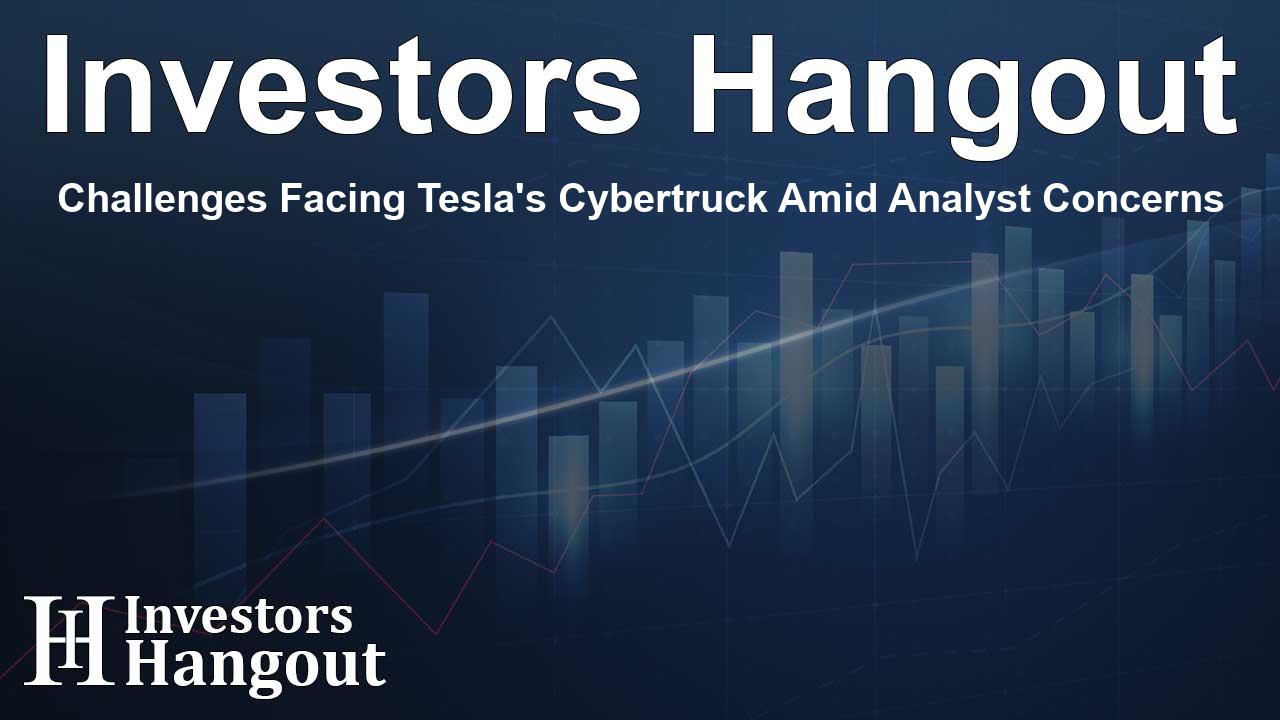Challenges Facing Tesla's Cybertruck Amid Analyst Concerns

Concerns Grow Over Tesla's Cybertruck Performance
Recently, Tesla (NASDAQ: TSLA) has come under scrutiny as analysts reveal a troubling outlook regarding the performance of its highly anticipated Cybertruck. Despite price reductions, the company reported delivering only about 15,000 units in the last quarter and approximated a figure between 35,000 to 40,000 for the whole year. This starkly contrasts with Tesla's ambitious declarations of having received around 2 million orders for this innovative vehicle.
Analysts Question Cybertruck Viability
Bernstein analysts have raised significant concerns, suggesting that the Cybertruck might not be gross margin positive. This observation sparks doubts about the product's future, especially given Tesla's current profitability challenges and limited market demand. The analysts indicated a notable strategic misstep from Tesla’s management, emphasizing the potential opportunity cost incurred due to the cybertruck's prolonged four-year development. During this time, the focus diverted from creating more affordable vehicles, which the automotive giant now urgently requires.
Tesla's Margins and Earnings Projections
Furthermore, the analysts highlighted the continuous decline in Tesla's auto gross margins, noting that aggressive pricing strategies and financing incentives implemented in the fourth quarter contributed to this trend. They project that, if regulatory credits and one-off software or full self-driving revenue are set aside, Tesla's auto gross margins may slump below 15%. This situation places them at a disadvantage compared to most internal combustion engine manufacturers in the U.S. and Europe, with the exception of Ford (NYSE: F).
Future Earnings Outlook
Looking ahead, Bernstein's analysts anticipate earnings for Tesla may taper off from $2.60 per share in the current year to approximately $2.10 in the upcoming year. Even with an expected influx of about $1 billion from regulatory credits, the forecast remains pessimistic, indicating the challenges Tesla faces in the evolving automotive market.
The Robotaxi Vision Under Scrutiny
Besides the Cybertruck, Tesla's advancements in the robotaxi segment have also drawn critical assessment. As the company pivots investor attention toward autonomous vehicles, analysts express skepticism about Tesla's capacity to surpass its competitors in this rapidly advancing field. Among the concerns raised is Tesla's potentially limited sensor suite and the looming regulatory challenges that could impede progress.
Competition in the AI and Autonomy Space
Even if Tesla manages to achieve Level 5 autonomy ahead of other players, analysts ponder whether it can maintain its leading position in the industry. They argue that as AI computing capabilities grow, other companies will likely catch up faster than anticipated. This democratization of the technology may level the playing field, reducing Tesla’s ability to command a premium on pricing and raising questions about sustained profitability.
Delivery Metrics and Operational Progress
Amid these discussions, Tesla's fourth-quarter delivery figures did see a modest increase of 2% year-over-year, totaling 495,600 units. However, this still fell short of expectations, causing a slight dip in annual delivery performance. On a more positive note, energy storage shipments showcased outstanding growth, soaring by 244% to reach 11 GWh during the same quarter. This statistic shines a light on a segment of the business that continues to expand, presenting opportunities for Tesla moving forward.
Frequently Asked Questions
What challenges does the Cybertruck face according to analysts?
Analysts express that the Cybertruck is struggling with underwhelming performance in terms of deliveries and profitability, leading to doubts about its success.
How do Tesla's auto gross margins compare to its competitors?
Tesla's gross margins are projected to fall below 15%, lagging behind most competitors in the automotive market, including traditional internal combustion engine manufacturers.
What is the forecast for Tesla's earnings in the coming year?
Analysts forecast that Tesla's earnings will decline from $2.60 per share in 2023 to approximately $2.10 in 2024, indicating potential financial hurdles.
How is Tesla's progress in the robotaxi sector viewed?
Analysts are skeptical about Tesla's competitiveness in the robotaxi market, citing limitations in technology and regulatory obstacles that may hinder advancements.
What was the performance of Tesla's energy storage segment?
Tesla's energy storage shipments grew significantly, achieving a remarkable 244% increase to 11 GWh during the last quarter, indicating a strong market for this product.
About The Author
Contact Lucas Young privately here. Or send an email with ATTN: Lucas Young as the subject to contact@investorshangout.com.
About Investors Hangout
Investors Hangout is a leading online stock forum for financial discussion and learning, offering a wide range of free tools and resources. It draws in traders of all levels, who exchange market knowledge, investigate trading tactics, and keep an eye on industry developments in real time. Featuring financial articles, stock message boards, quotes, charts, company profiles, and live news updates. Through cooperative learning and a wealth of informational resources, it helps users from novices creating their first portfolios to experts honing their techniques. Join Investors Hangout today: https://investorshangout.com/
The content of this article is based on factual, publicly available information and does not represent legal, financial, or investment advice. Investors Hangout does not offer financial advice, and the author is not a licensed financial advisor. Consult a qualified advisor before making any financial or investment decisions based on this article. This article should not be considered advice to purchase, sell, or hold any securities or other investments. If any of the material provided here is inaccurate, please contact us for corrections.
